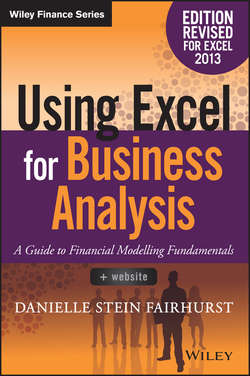Читать книгу Using Excel for Business Analysis - Fairhurst Danielle Stein - Страница 4
На сайте Литреса книга снята с продажи.
Preface
ОглавлениеThis book was written from course materials compiled over many years of training in analytical courses in Australia and globally – most frequently courses such as Financial Modelling in Excel, Data Analysis & Reporting in Excel, and Budgeting & Forecasting in Excel, both as face-to-face workshops and online courses. The common theme is the use of Microsoft Excel, and I’ve refined the content to suit the hundreds of participants and their questions over the years. This content has been honed and refined by the many participants in these courses, who are my intended readers. This book is aimed at you, the many people who seek financial analysis training (either by attending a seminar or self-paced by reading this book) because you are seeking to improve your skills to perform better in your current role, or to get a new and better job.
When I started financial modelling in the early nineties, it was not called financial modelling– it was just “using Excel for business analysis,” and this is what I’ve called this book. It was only just after the new millennium that the term financial modelling gained popularity in its own right and became a required skill often listed on analytical job descriptions. This book spends quite a bit of time in Chapter 1 defining the meaning of a financial model, as it’s often thought to be something that is far more complicated than it actually is. Many analysts I’ve met are building financial models already without realising it, but they do themselves a disservice by not calling their models, “models”!
However, those who are already building financial models are not necessarily following good modelling practice as they do so. Chapter 3 is dedicated to the principles of best modelling practice, which will save you a lot of time, effort, and anguish in the long run. Many of the principles of best practice are for the purpose of reducing the possibility of error in your model, and there is a whole section on strategies for reducing error in Chapter 4.
The majority of Excel users are self-taught, and therefore many users will often know highly advanced Excel tools, yet fail to understand how to use them in the context of building a financial model. This book is very detailed, so feel free to skip sections you already know. Because of the comprehensive nature of the book, much of the detailed but less commonly used content, such as instructions for the older Excel 2003 users, has been moved to the companion website at www.wiley.com/go/steinfairhurstrevised. References to the content on the website, and many cross-references to other sections of the book, can be found throughout the book.
BOOK OVERVIEW
This book has 12 chapters, which can be grouped into three sections. Whilst they do follow on from each other with the most basic concepts at the beginning, feel free to jump directly to any of the chapters. The first section – Chapters 1 to 3 – addresses the least technical topics about financial modelling in general, such as tool selection, model design, and best practice.
The second section – Chapters 4 to 8 – is extremely practical and hands-on. Here I have outlined all of the tools, techniques, and functions in Excel that are commonly used in financial modelling. Of course it does not cover everything Excel can do, but it covers the “must-know” tools.
The third section – Chapters 9 to 12 – is the most important in my view. This covers the use of Excel in financial modelling and analysis. This is really where the book differs from other “how-two” Excel books. Chapter 9 covers some commonly used techniques in modelling, such as escalation, tiering tables, and depreciation – how to actually use Excel tools for something useful! Chapter 11 covers the several different methods of performing scenarios and sensitivity analysis (basically the whole point of financial modelling to my mind). Last, Chapter 12 covers the often-neglected task of presenting model output. Many modellers spend days or weeks on the calculations and functionality, but fail to spend just a few minutes or hours on charts, formatting, and layout at the end of the process, even though this is what the user will see, interact with, and eventually use to judge the usefulness of the model.
ACKNOWLEDGMENTS
This book would not have been written had it not been for the many people who have attended my training sessions, participated in online courses, and contributed to the forums. Your continual feedback and enthusiasm for the subject inspired me to write this book and it was because of you that I realized how much a book like this was needed.
The continued support of my family and network made this project possible. In particular, Mike, my husband, for his unconditional commitment and to whom this book is dedicated; my children who give me so much joy; as well as my remarkable parents and siblings, who have always inspired and encouraged me without question. I would like to give a special thanks to my ever-patient assistant Susan Wilkin for her continuing dedication and diligence, as always. I could not do it without you all.
I hope you find the book both useful and enjoyable. Happy modelling!
